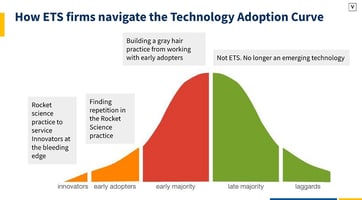When we introduced ETS we briefly touched on how the sales motion is different between ETS and...
How the ETS Sales Model Works

Not all service companies are built alike, and nowhere is that truer than when it comes to traditional technology services companies and emerging technology services companies. Although both operate in the market as service companies, their differences go right down to their DNA and carry over into how they approach one of the most vital processes for any business: sales.
How Traditional Technology Service Sales WorkTraditional technology service sales begin with an organization with an existing tech stack that needs engineers to run, maintain, and occasionally upgrade. The client knows what they need because they've been using it for a while, and that's also why they can evaluate your offer from a technical perspective. They're interested in your engineering team's certifications (of which there tend to be quite a few as an established technology matures), past experience, and availability. And they don't want to spend too much. This investment is a cost of business as usual, and they want the price to be equally unremarkable.
Enter: Emerging Tech Services
Once you enter the emerging tech services market, everything changes. These are the wild seas of cutting-edge innovation. Your customer is no longer in familiar territory. They now seek expert guidance to understand and eventually tackle an unknown problem. They need someone who can help turn this mystery into a puzzle.
Here's where we see some distinct aspects of the ETS sales model start to take shape:
The Value of the Technology
The first challenge ETS businesses must overcome is to convince prospective customers of the need for the emerging technology. They must establish the value of the technology, its usefulness, and its impact on the customer's business or industry. This is why well-run ETS businesses invest heavily in marketing, particularly digital marketing. This marketing doesn't take the form of self-promotion, as most traditional technology services do, but often focuses on raising market awareness and establishing the company's thought leadership in this emerging domain.
Your Value as a Provider
After proving that the emerging technology is worth investing in, ETS companies must prove that they are the right partner to implement it. This is trickier than it looks. Because emerging technologies are so new, substantial validation through things such as accrediting bodies, industry certifications, and major analyst firms' rankings (think Gartner's Magic Quadrant) may take a backseat. Often, big analyst firms haven't yet started ranking the emerging technology, nor has it been around long enough for industry certifications or accrediting bodies to mature.
This is where the power of third-party & platform partner validation shines. Badges and platform certifications carry far more weight than in a traditional tech sales paradigm. In the ETS sales model, these badges bridge a crucial gap since your customer's team won’t have an existing frame of reference to evaluate your technical skills. And while available certifications may not have matured, don't ignore them - being certified early can uniquely position you as an expert in this emerging space.
Thought leadership also goes beyond marketing in the ETS sales model. It helps your prospective customers understand the value you're offering to deliver. The more you can leverage your expertise to educate them, the more it reinforces your position as an authority on the subject. You can supplement this with case studies to showcase the value you've successfully delivered to other clients as you go along.
You must also leverage your platform partnerships strategically to establish your ETS business' deep expertise in delivering emerging technology solutions based on, built for, or extending those platforms.
The Consultative Sales Process
The third hallmark characteristic of the ETS sales model is consultative selling. Because you're working with emerging technology, you're better off not discussing your offer in terms of engineering hours and billing rates.
Skip the traditional sales talk and focus on a deep understanding of your prospective customer’s problem - not just to showcase your own expertise but because educating the customer is a critical part of selling an emerging technology to them. In fact, that’s why we recommend paid discovery calls that deliver value from the get-go.
New Procurement Challenges
Procurement departments tend to be among the most resistant to deviation from an established norm, so be prepared for friction when discussing MSAs and SOWs for an emerging technology service. ETS procurement needs to be customized to both the unique needs of the customer and the unique requirements or limitations of the emerging technology.
You can mitigate added friction through good communication that takes all relevant stakeholders into the loop as early as possible, a strong Proof of Concept, and by anticipating potential objections & negotiations.
Wrapping Up

Selling ETS often requires a diametrically different approach from selling TTS, as the table above summarizes. The ETS sales model has much more in common with SaaS sales instead.
Like SaaS businesses, ETS businesses begin by educating the market. They leverage platforms, in this case for validation, and they offer flexible contracting that focuses on value delivered instead of billing hours and team augmentation. When looking to build a sales pipeline or recruit sales teams, it helps to keep these differences in mind to ensure success in such a model.
If you're thinking of launching an ETS startup or if you already have one, check out our whitepaper about the 3 reasons why your tech services startup might scale slowly and what to do about it.




